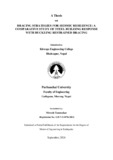Please use this identifier to cite or link to this item:
https://elibrary.khec.edu.np/handle/123456789/859Full metadata record
| DC Field | Value | Language |
|---|---|---|
| dc.contributor.advisor | Prof. Dr. Chandra Kiran Kawan; Er. Sudip Karanjit | - |
| dc.contributor.author | Niwesh Tamrakar | - |
| dc.date.accessioned | 2025-02-10T10:25:58Z | - |
| dc.date.available | 2025-02-10T10:25:58Z | - |
| dc.date.issued | 2024 | - |
| dc.identifier.uri | https://elibrary.khec.edu.np:8080/handle/123456789/859 | - |
| dc.description.abstract | The starting point for this research was the understanding that, although RCC buildings have better structural performance, their resource- and time-intensive construction methods presented considerable difficulties. This resulted in the study of RCC buildings, which are widely used in Nepal. On the other hand, steel structures were shown to be a good substitute, especially in regions that are prone to earthquakes, due to its high tensile strength, resilience to corrosion, and ease of construction. In particular, Buckling Restrained Braces (BRBs), Concentric Braced Frames (CBFs), and Moment Resisting Frames (MRFs) were investigated in the study. Better buckling resistance against compressive stresses, improved energy dissipation, and increased ductility are among the primary factors why BRBs are considered to be more seismically resilient. The crucial importance of bracing in mid- to high-rise structures was highlighted by the literature analysis carried out as part of this study, which also demonstrated how the choice of bracing has a substantial impact on displacement, base shears, along with the structure's overall seismic response. As opposed to alternate systems such as Special Moment Resisting Frames (SMRFs) and Concentrically Braced Frames (CBFs), Buckling-Restrained Braces (BRBs) showed improved seismic performance, especially in minimizing lateral drifts and boosting structural stability. According to studies, BRBFs are 50% more effective than steel weight and dramatically reduce seismic drifts. The study included results from earlier investigations that found BRBs to perform better than conventional bracing techniques. These investigations demonstrated that BRBs are particularly useful in steel frames that are subjected to seismic stresses because they not only increase energy dissipation but additionally provide increased stability and improved seismic performance. Using the Finite Element Method (FEM) to model buildings with varying bracing configurations and analyze performance, the research technique entailed choosing buildings of varying heights. This comparison analysis's findings showed that BRBs provide the best amount of seismic resilience, especially in taller structures. The application of BRBs improved the overall strength of the structure during seismic events by significantly lowering the maximum storey displacement, inter-storey drift, as well as the incidence of plastic hinges in critical failure zones. According to the study, BRBs fared better seismically than alternative bracing systems, particularly in high-rise buildings. According to the research, BRBs are a very practical way to increase the safety and robustness of steel buildings in areas that are vulnerable to earthquakes. | - |
| dc.format.extent | 100 p | - |
| dc.title | BracIng Strategies for Seismic Resilience: A Comparative Study of Steel BuildIng Response With BucklIng Restrained Bracing | - |
| dc.type | Thesis | - |
| local.college.name | Khwopa Engineering College | - |
| local.degree.department | P. G. Department of Earthquake Engineering | - |
| local.college.batch | 2076 | - |
| local.degree.name | ME Earthquake | - |
| local.degree.level | Masters | - |
| local.item.accessionnumber | D.1522 | - |
| local.item.reportnumber | Registration No.: 0.35-7-3-04796-2021 | - |
| Appears in Collections: | Master of Science (M.Sc) in Earthquake engineering | |
Files in This Item:
| File | Description | Size | Format | |
|---|---|---|---|---|
| 021_Niwesh Tamrakar.pdf Restricted Access | 11.38 MB | Adobe PDF |  View/Open Request a copy |
Items in DSpace are protected by copyright, with all rights reserved, unless otherwise indicated.
